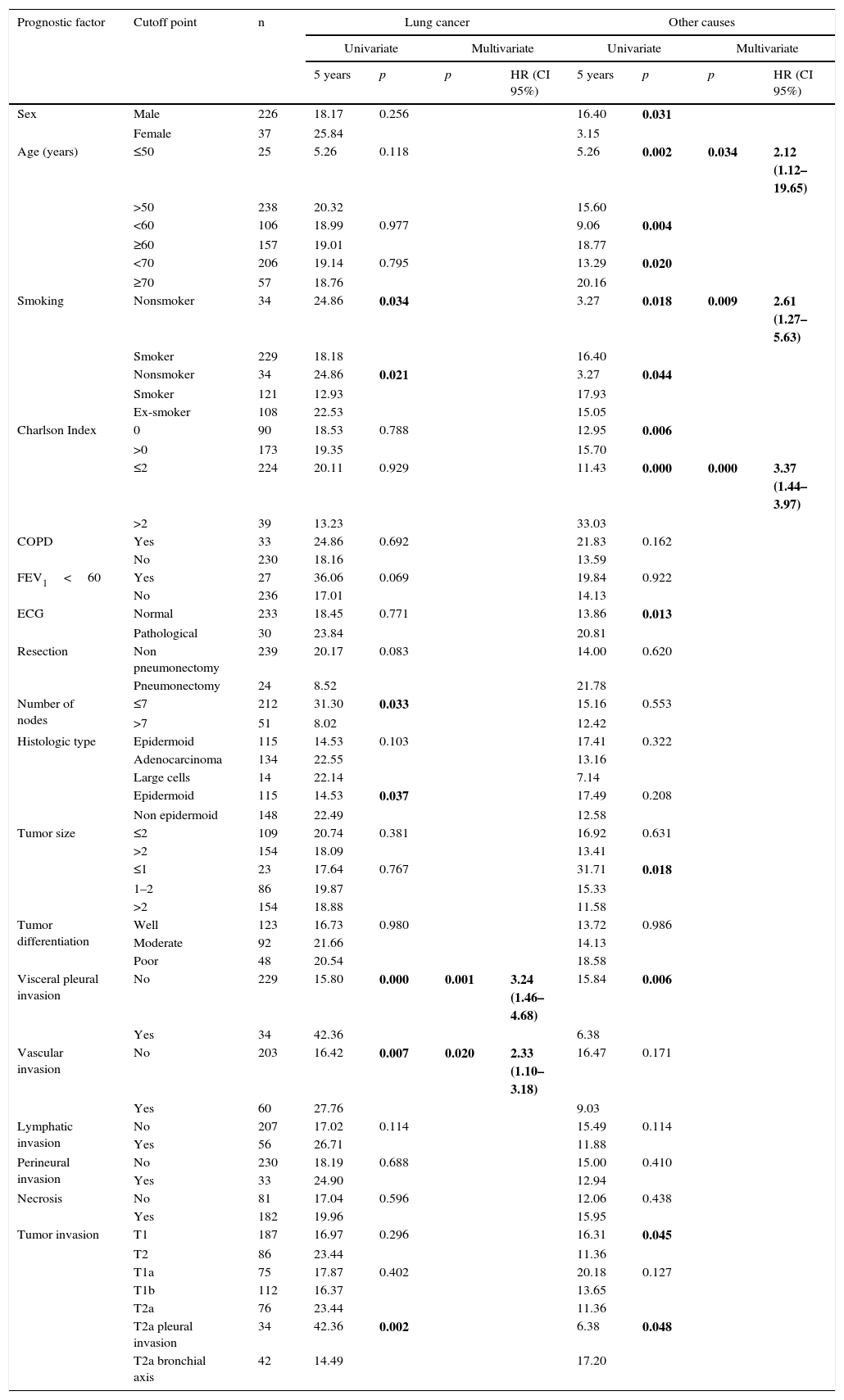Survival studies of non-small cell lung cancer (NSCLC) are usually based on the Kaplan–Meier method. However, other factors not covered by this method may modify the observation of the event of interest. There are models of cumulative incidence (CI), that take into account these competing risks, enabling more accurate survival estimates and evaluation of the risk of death from other causes. We aimed to evaluate these models in resected early-stage NSCLC patients.
Patients and methodThis study included 263 patients with resected NSCLC whose diameter was ≤3cm without node involvement (N0). Demographic, clinical, morphopathological and surgical variables, TNM classification and long-term evolution were analyzed. To analyze CI, death by another cause was considered to be competitive event. For the univariate analysis, Gray's method was used, while Fine and Gray's method was employed for the multivariate analysis.
ResultsMortality by NSCLC was 19.4% at 5 years and 14.3% by another cause. Both curves crossed at 6.3 years, and probability of death by another cause became greater from this point. In multivariate analysis, cancer mortality was conditioned by visceral pleural invasion (VPI) (p=0.001) and vascular invasion (p=0.020), with age>50 years (p=0.034), smoking (p=0.009) and the Charlson index≥2 (p=0.000) being by no cancer.
ConclusionsBy the method of CI, VPI and vascular invasion conditioned cancer death in NSCLC>3cm, while non-tumor causes of long-term death were determined.
Los estudios de supervivencia en el carcinoma pulmonar no microcítico (CPNM) se basan, habitualmente, en el método de Kaplan–Meier. Sin embargo, otros factores, no contemplados por este método, pueden modificar la observación del suceso de interés. Existen modelos de incidencia acumulativa (IA) que, teniendo en cuenta estos riesgos competitivos, permiten estimaciones más precisas de la supervivencia y valorar el riesgo de muerte por otras causas. Nuestro objetivo es evaluar dichos modelos en pacientes operados de CPNM en estadio precoz.
Pacientes y métodoEstudio de 263 pacientes resecados de un CPNM con un diámetro ≤3cm y sin afectación ganglionar (N0). Se analizaron variables demográfico-clínicas, morfopatológicas, quirúrgicas, clasificación TNM y evolución a largo plazo. Para el análisis de la IA se consideró suceso competitivo la mortalidad por otra causa. Para el análisis univariante se utilizó el método de Gray, y para el multivariante, el de Fine y Gray.
ResultadosLa mortalidad por CPNM fue del 19,4% a los 5 años y del 14,3% por otra causa. Ambas curvas se cruzaron a los 6,3 años, siendo la probabilidad de muerte por otra causa mayor a partir de este punto. En el análisis multivariante, condicionaron la mortalidad por cáncer la invasión pleural visceral (IPV) (p=0,001) y la vascular (p=0,020), mientras que para la mortalidad por otra causa diferente del cáncer lo fueron la edad>50 años (p=0,034), el tabaquismo (p=0,009) y el índice de Charlson≥2 (p=0,000).
ConclusionesMediante el método de IA, la IPV y la invasión vascular condicionaron la muerte por cáncer en CPNM>3cm y se determinaron cuáles fueron las causas no tumorales de muerte a largo plazo.









